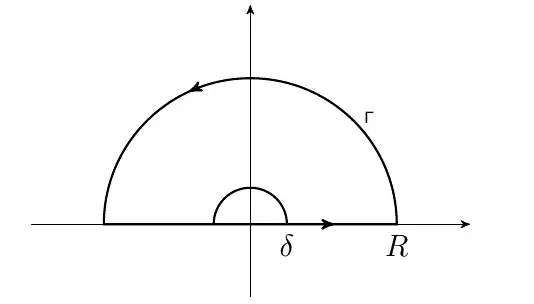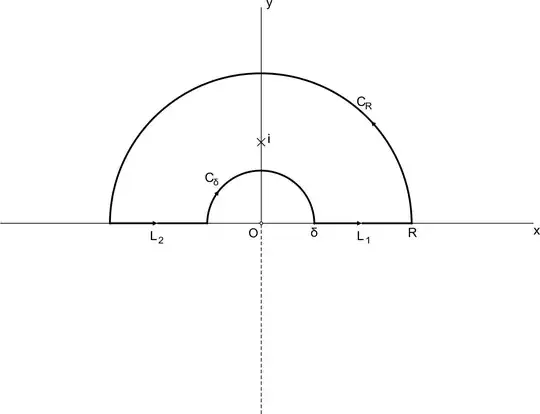I recently had an extremely failed attempt at asking the same question, so I am posting the same question more or less to hope that someone can give me feedback.
Consider the integral:
$$\int_{0}^{\infty} \frac{\log^2(x)}{x^2 + 1} dx$$
$\hskip1in$
Image taken and modified from: Complex Analysis Solution (Please Read for background information).
$R$ is the big radius, $\delta$ is the small radius.
Actually, lets consider $u$ the small radius. Let $\delta = u$
Ultimately the goal is to let $u \to 0$
We can parametrize,
$$z = ue^{i\theta}$$
$$\int_{\delta} f(z)dz = (-)\cdot\int_{0}^{\pi} \frac{(i\theta + \log(u))^2\cdot (uie^{i\theta})}{(ue^{i\theta})^2 + 1} d\theta$$
$$\left | \int_{0}^{\pi} \frac{(i\theta + \log(u))^2\cdot (uie^{i\theta})}{(ue^{i\theta})^2 + 1} d\theta \right | \le \int_{0}^{\pi} \frac{|(i\theta + \log(u))|^2\cdot(u)}{|(ue^{i\theta})^2 + 1 |} d\theta$$
$$|(ue^{i\theta})^2 + 1 | < u^2 + 1 $$
$$\frac{1}{u^2 + 1} < \frac{1}{|(ue^{i\theta})^2 + 1 |}$$
Since the maximum value of $\theta$ is $\theta = \pi$
$$|(i\theta + \log(u))| = \sqrt{\log^2(u) - \theta^2} \le \sqrt{\log^2(u) + \pi^2}$$
So:
$$|(i\theta + \log(u))|^2 \le \log^2(u) + \pi^2$$
Then:
$$|(i\theta + \log(u))|^2 \le \log^2(u) + \pi^2$$
For values $u$ near $0$.
$$(u)|(i\theta + \log(u))|^2 \le (\log^2(u) + \pi^2)u \le (\pi^2)u + 5\pi^2$$
Therefore,
$$\frac{|\log(z)|}{|z^2 + 1|} \le \frac{(\pi^2)u + 5\pi^2}{u^2 + 1}$$
Then we take the limit as $u \to 0$ which makes the RHS of the inequality 0.
hence the LHS upperbound is $0$.
So is the contour integral around the small semi circle $\delta = 0$?
How do I do this?
Thanks
